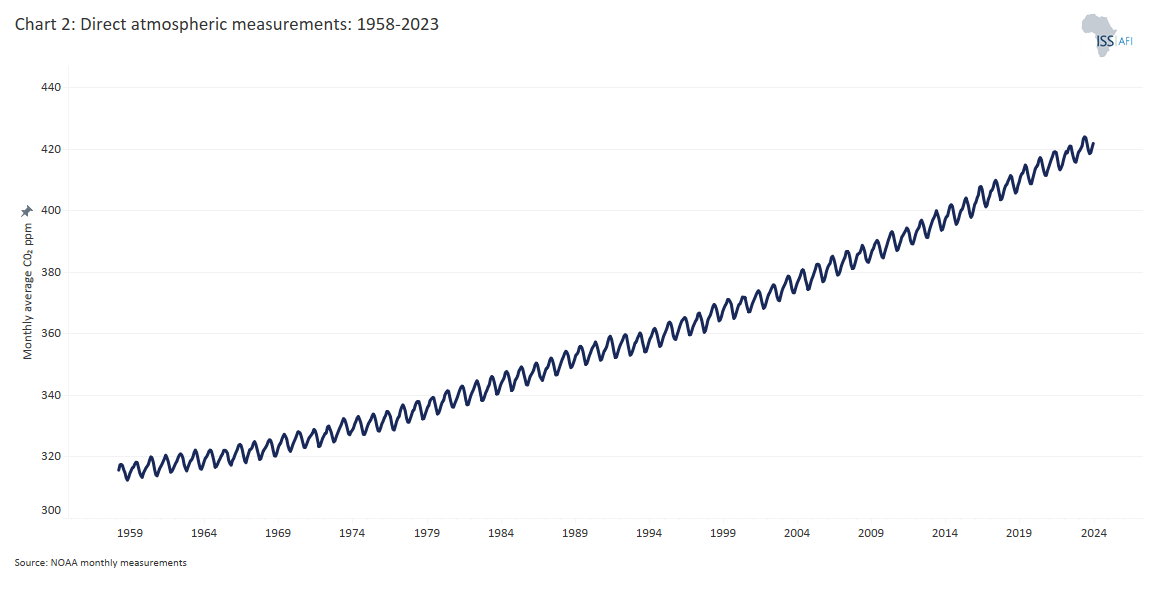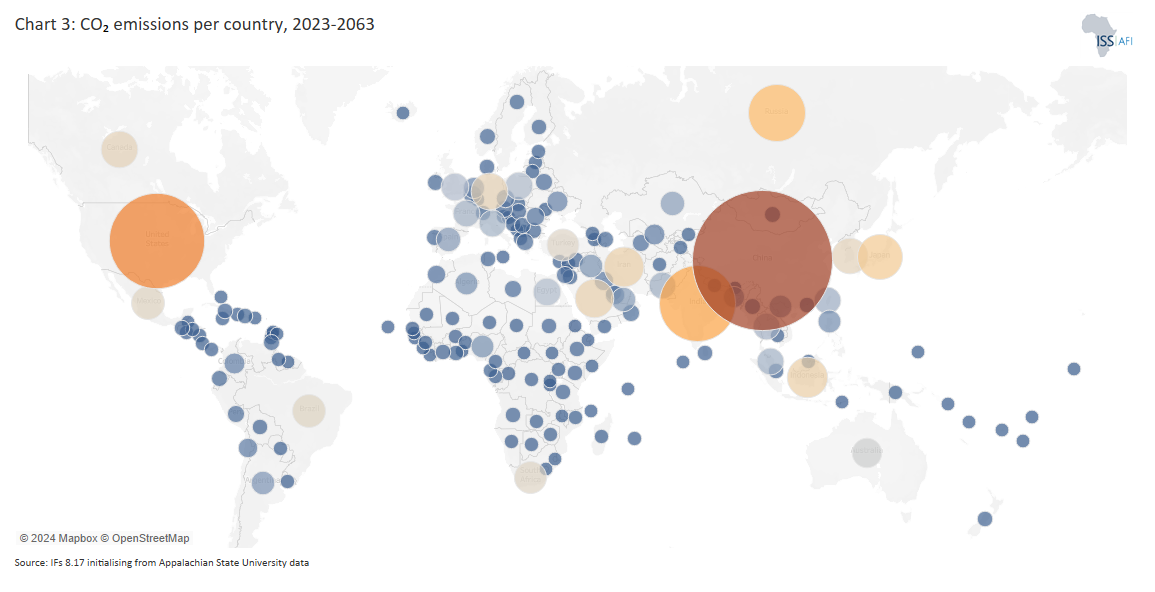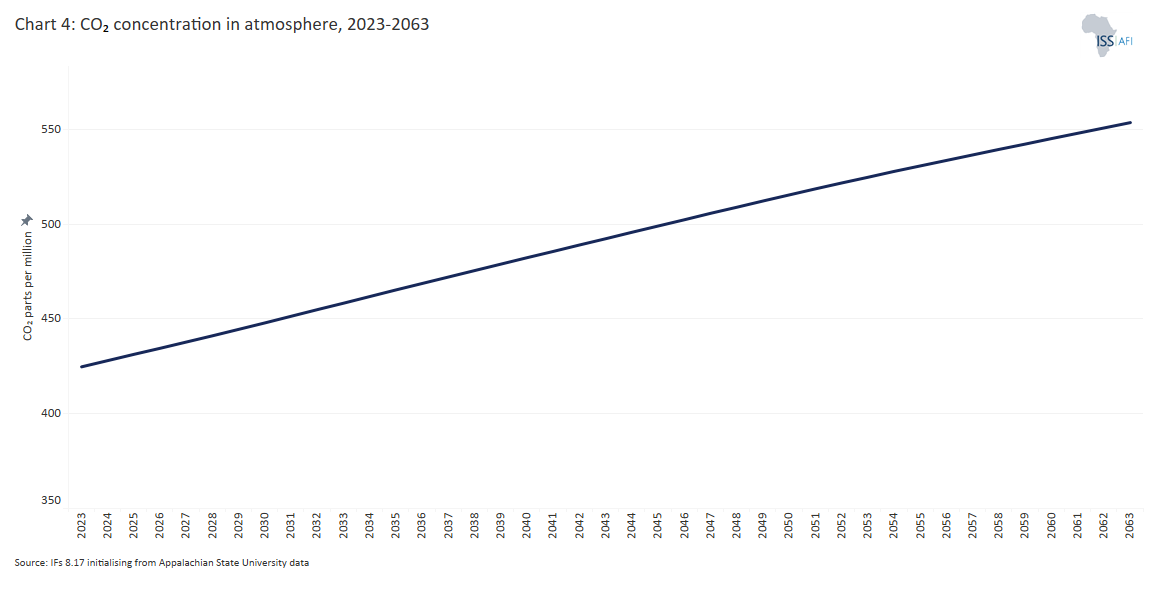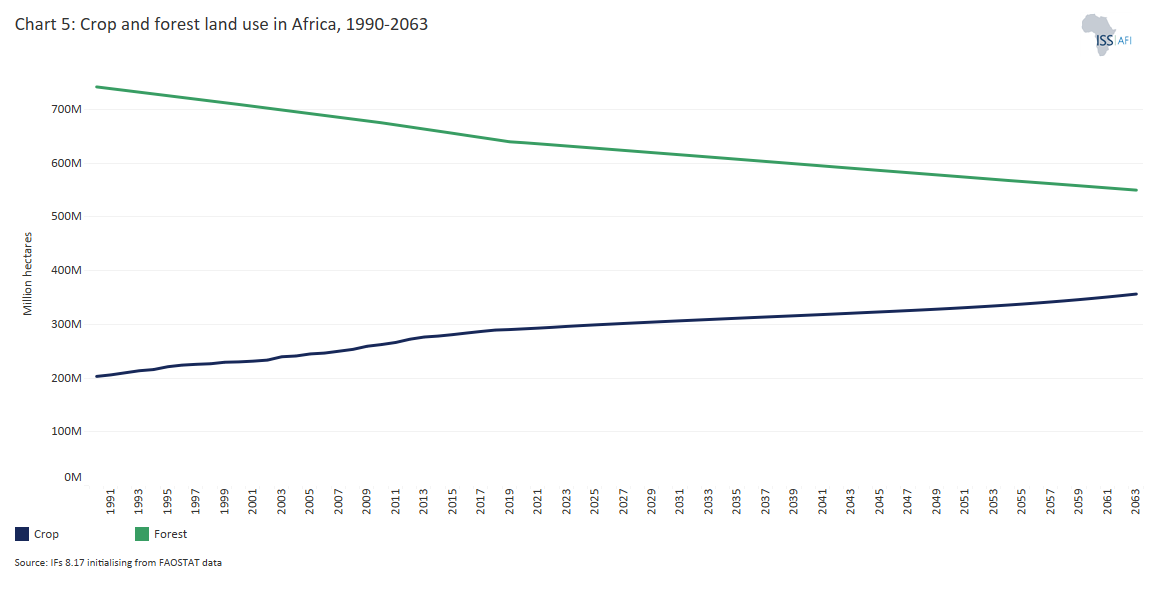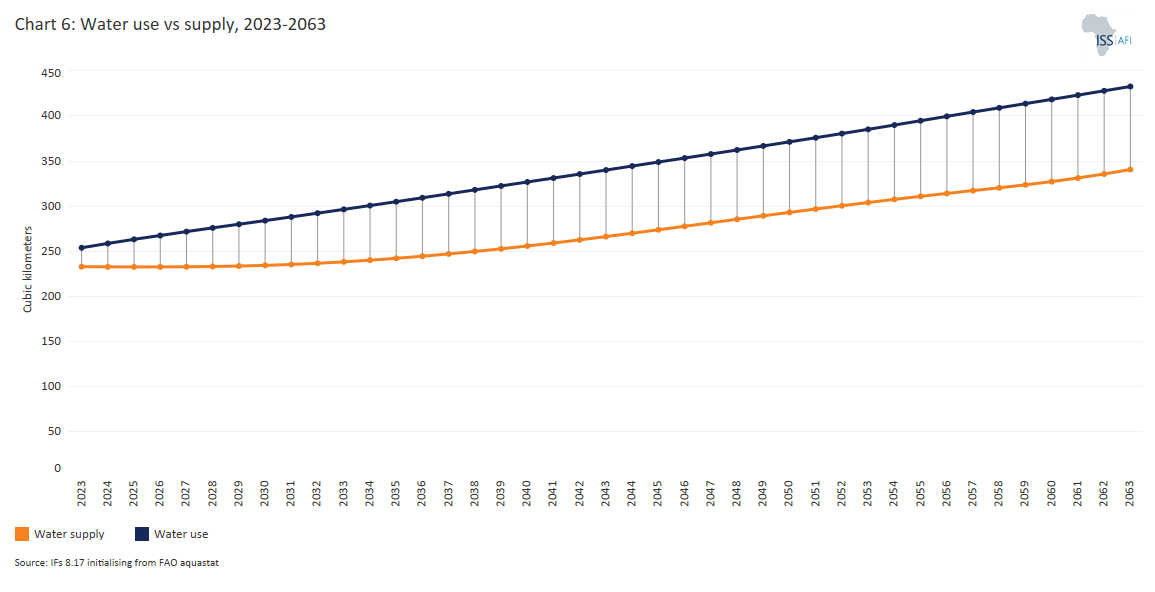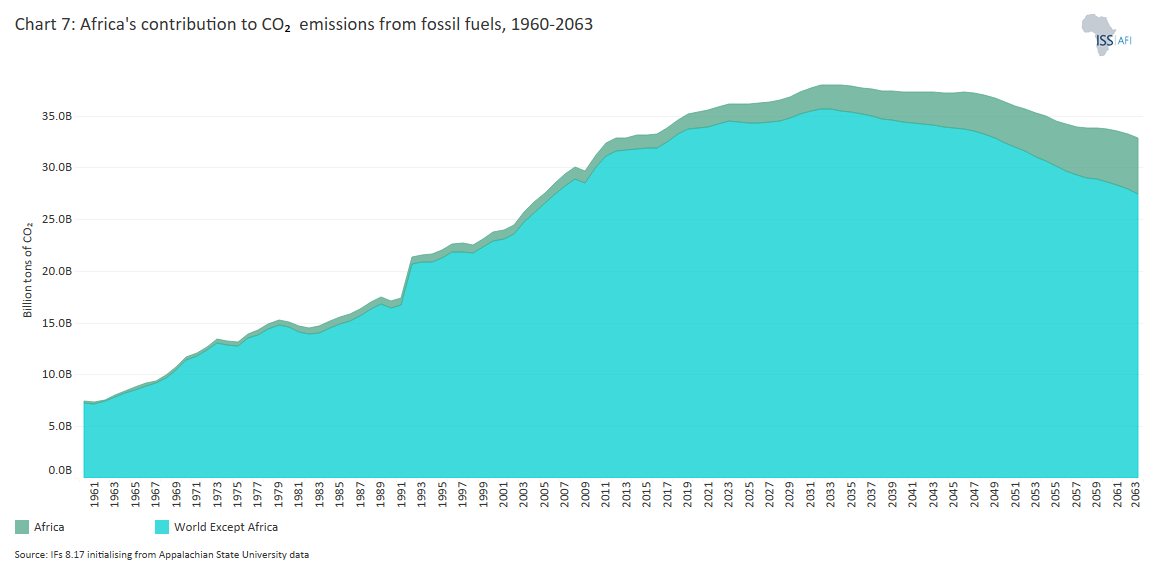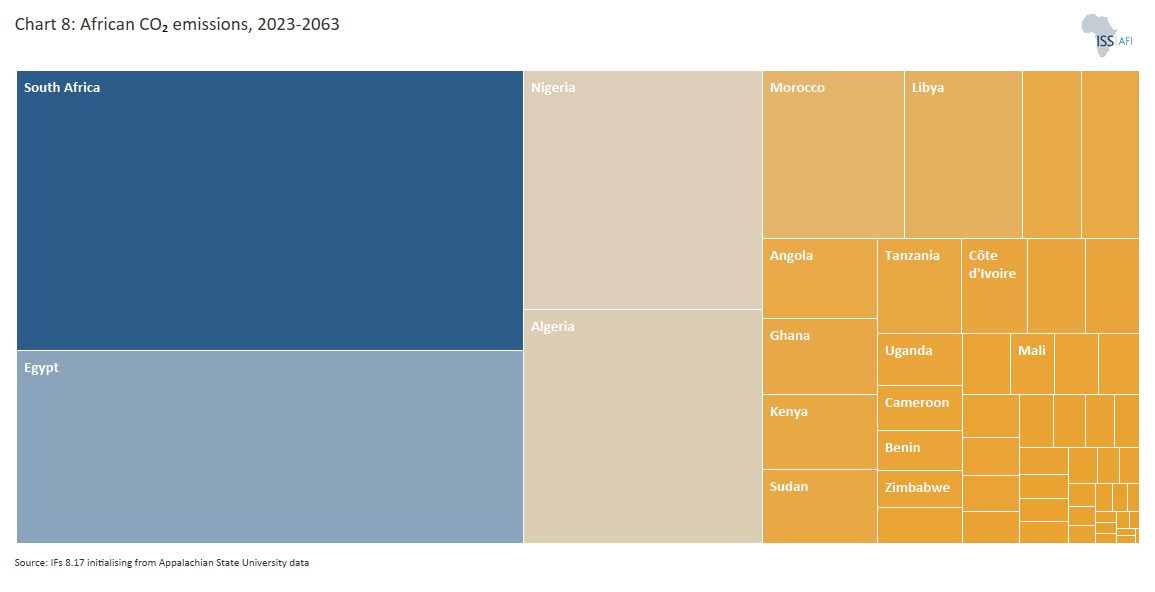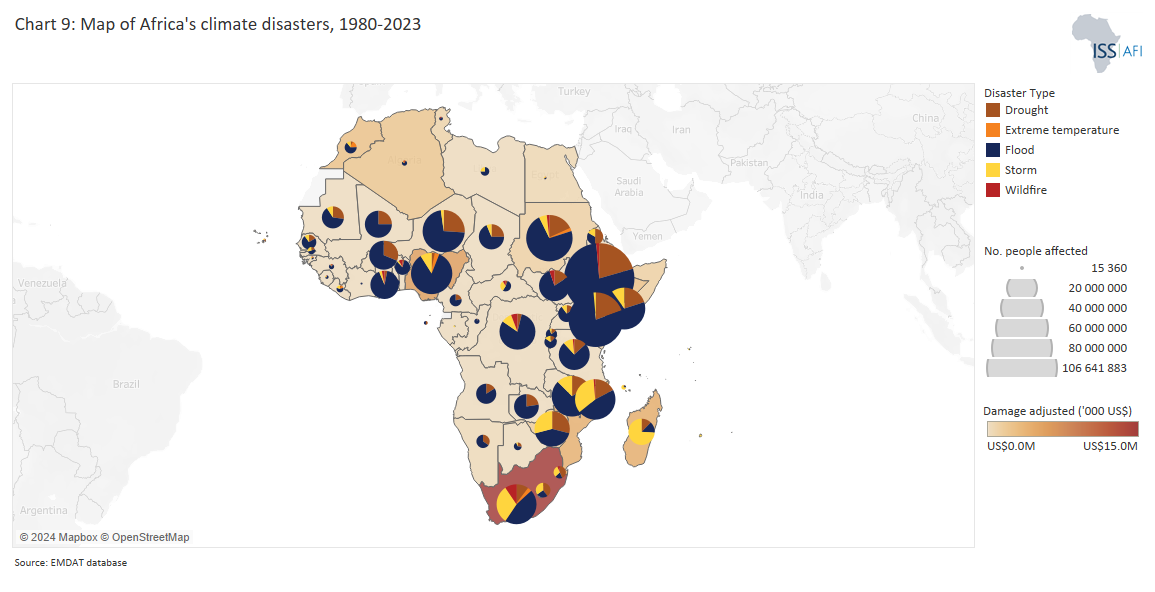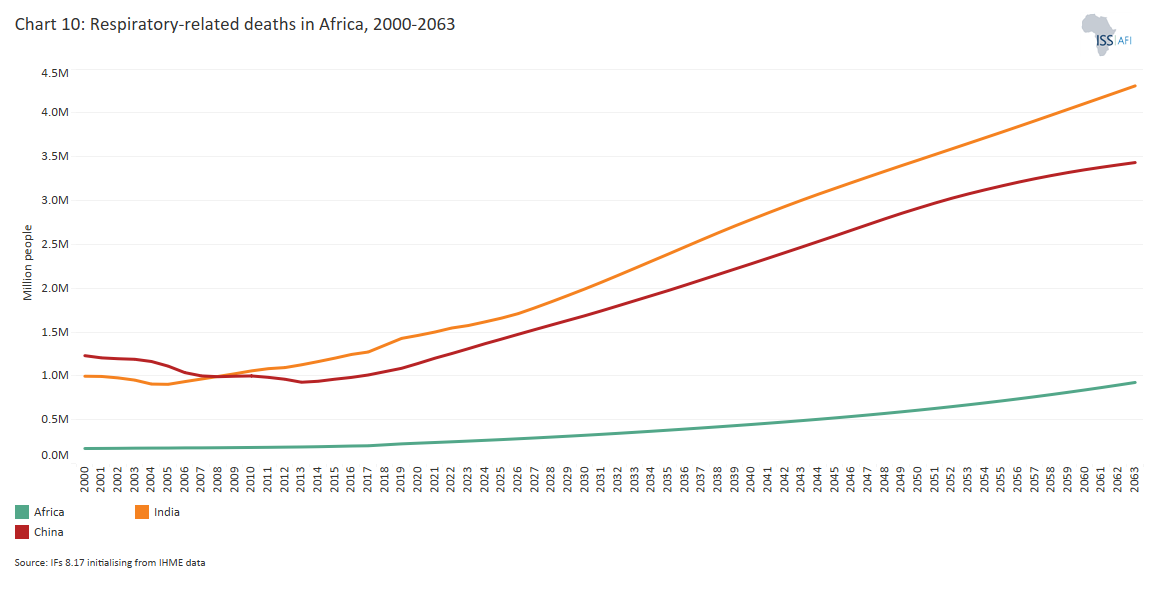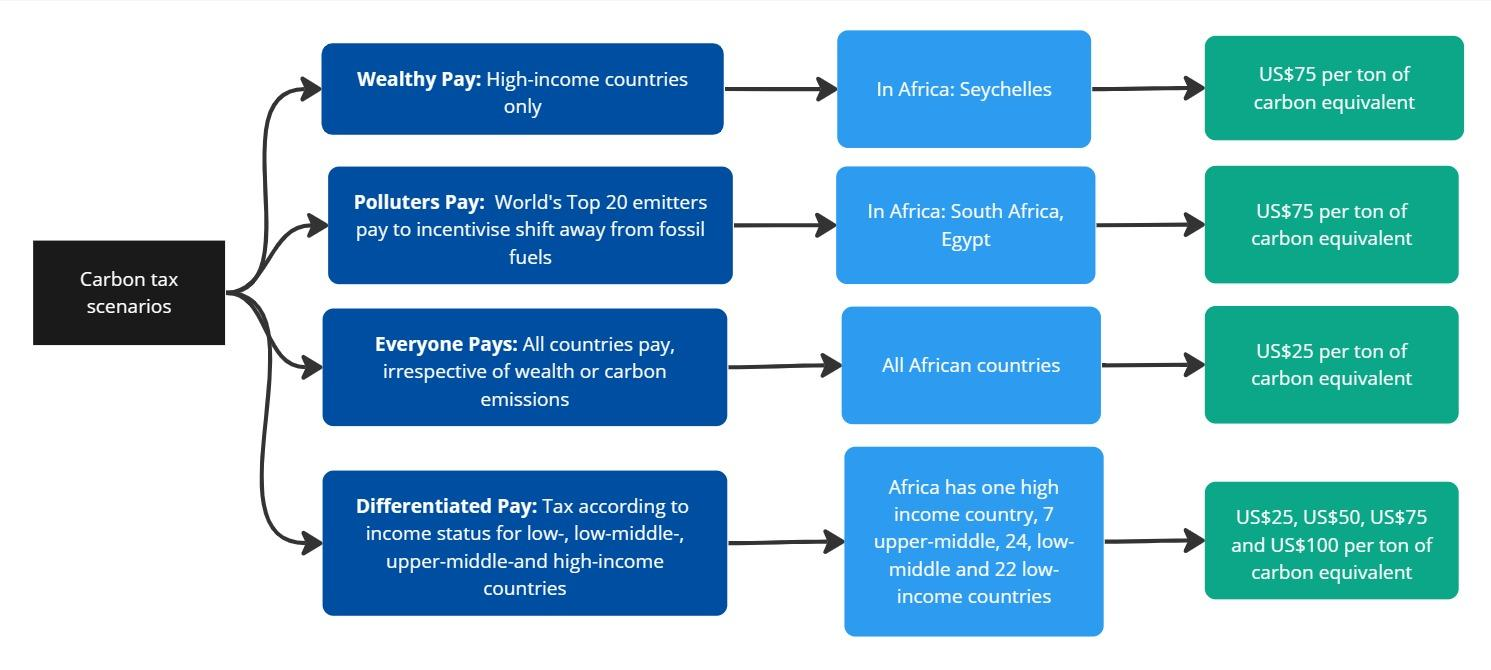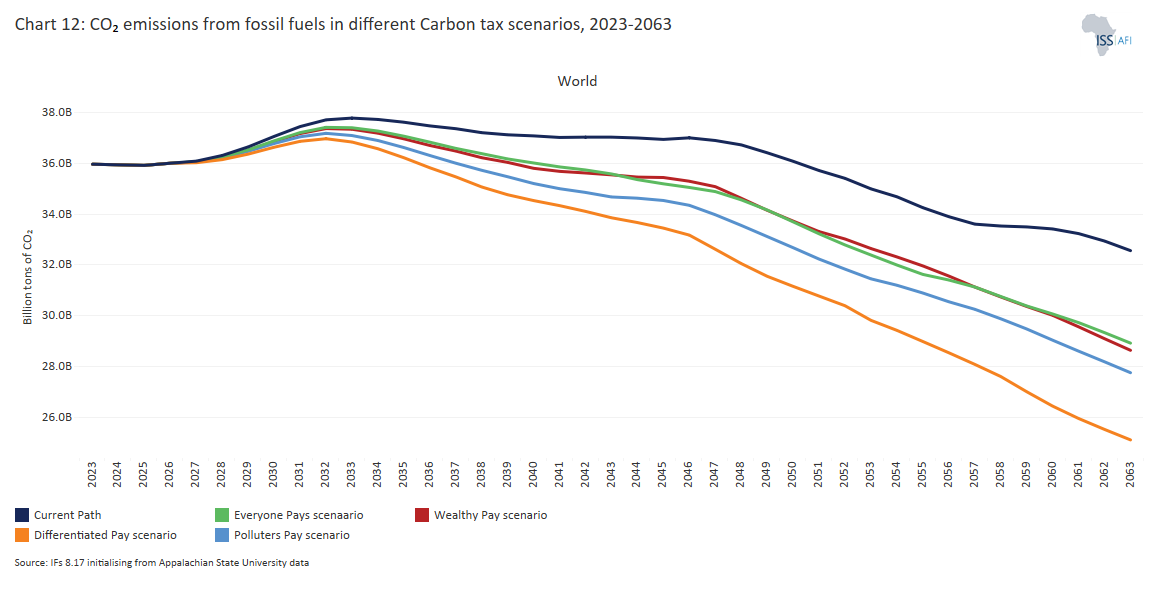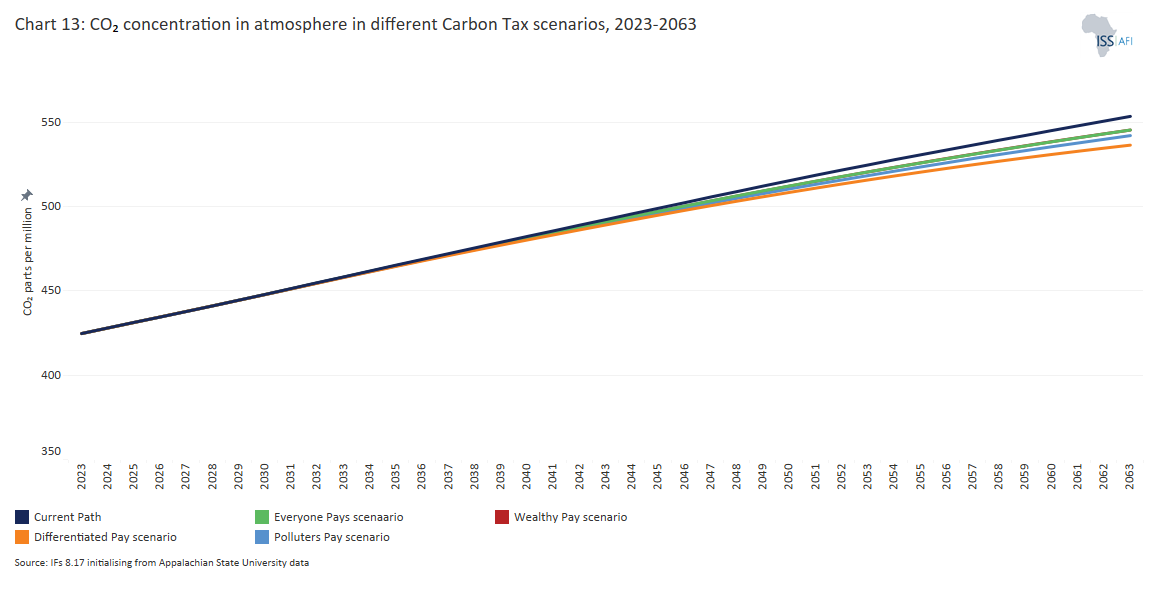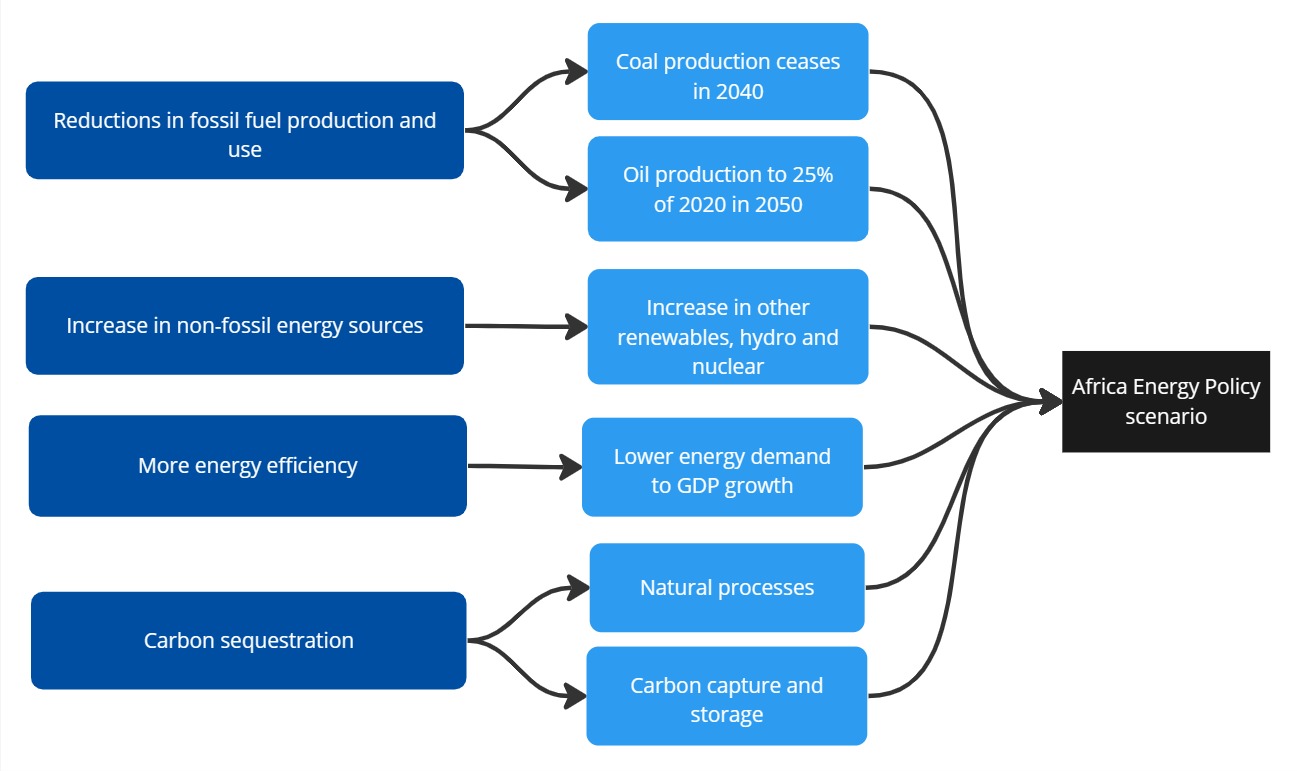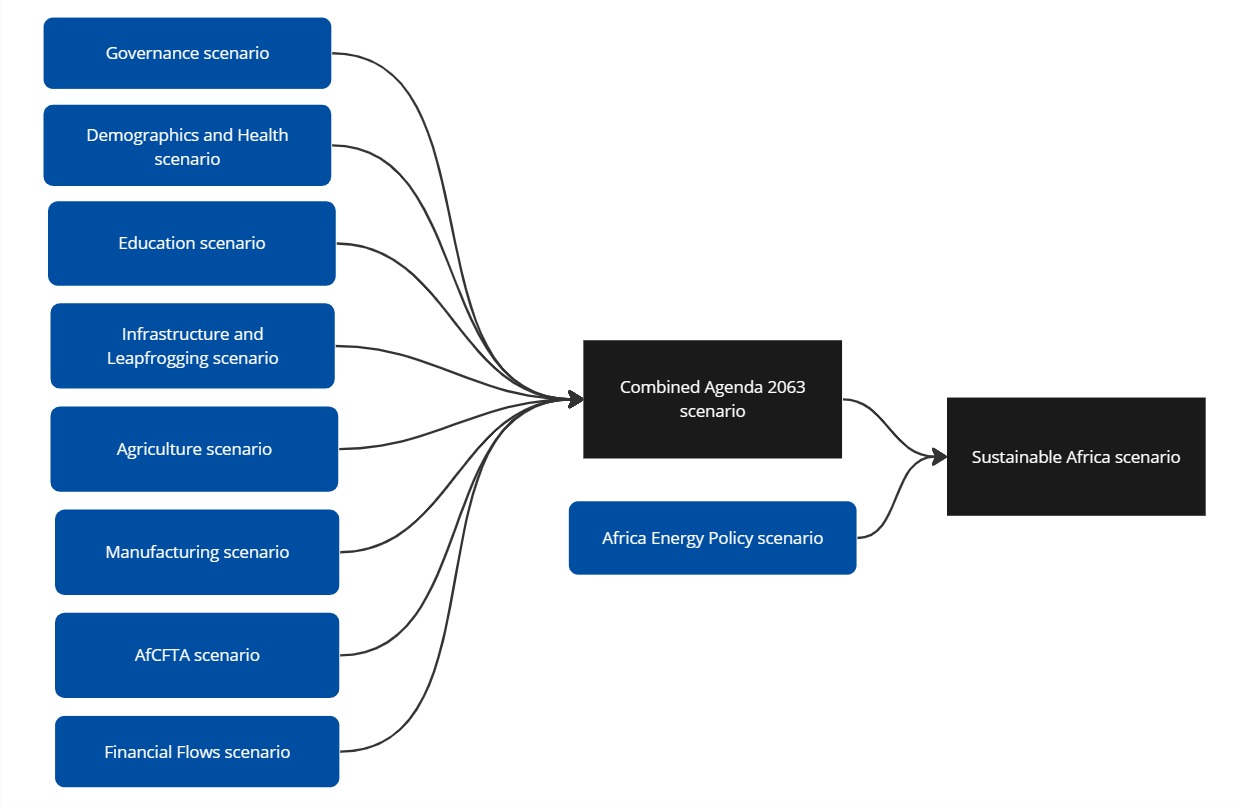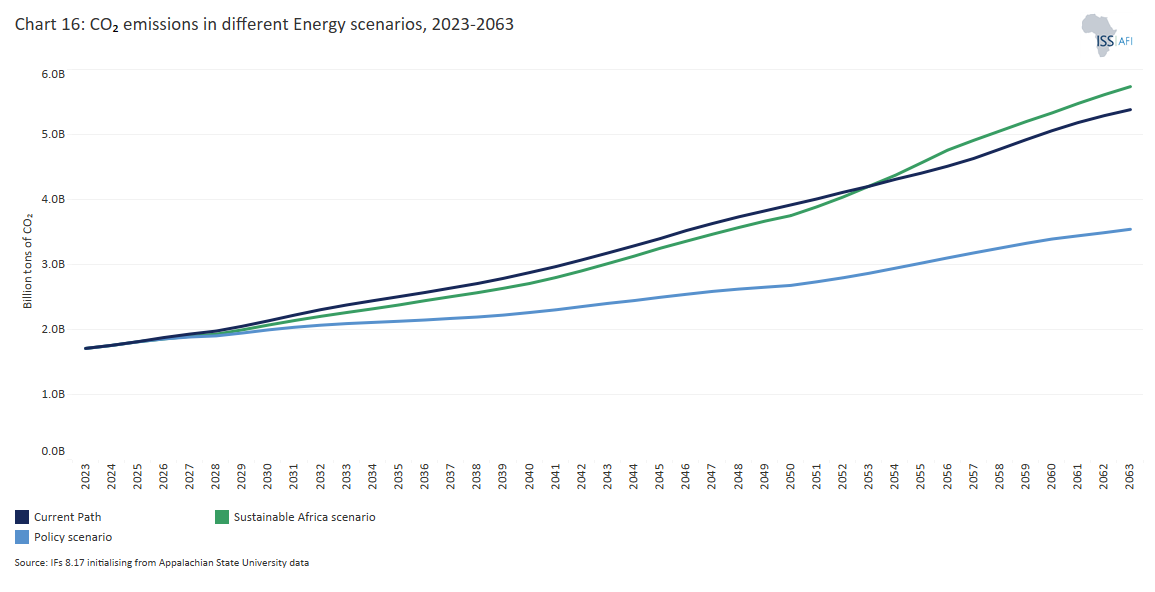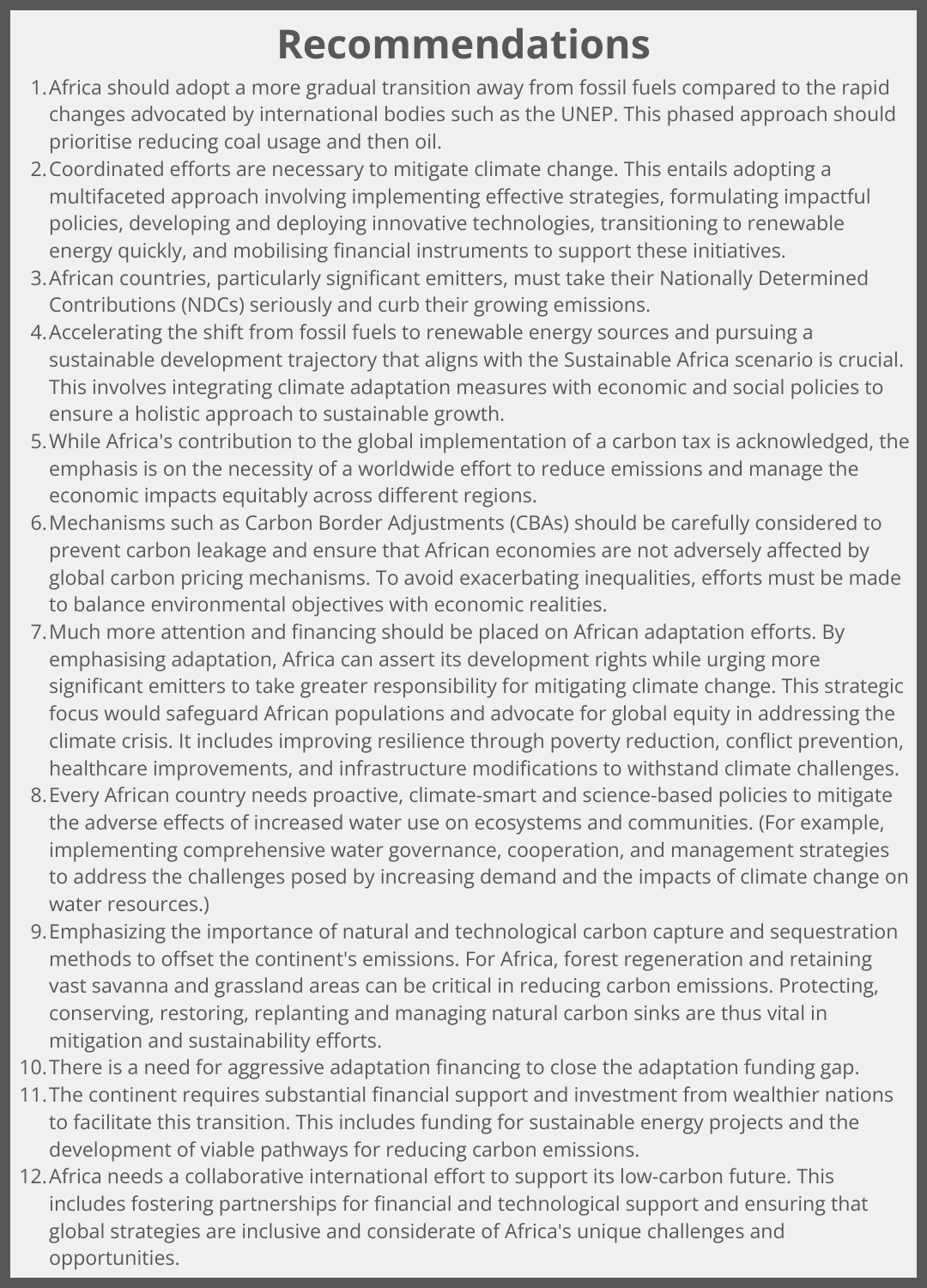 14 Climate
14 Climate
Feedback welcome
Our aim is to use the best data to inform our analysis. See our About page for information on the IFs forecasting platform. We appreciate your help and references for improvements via our feedback form.
This theme on Africa’s Climate Futures explores the trends related to climate change. It focuses on Africa's unique position as a minor emitter of global carbon yet a region disproportionately affected by the impact of climate changes. We model Africa’s energy demand and carbon emissions, with fossil fuels and deforestation as major contributors, and then discusses strategies for mitigation and adaptation, including a global carbon tax.
The theme complements the separate theme on Africa’s Energy Futures. Energy production and carbon emissions are closely linked, and we use the same comprehensive energy transition and emissions scenarios across the two themes. We use 2050 as a standard reference year to enable comparisons with global ambitions such as ‘getting to net zero by 2050’. We extend the forecast horizon to 2063 to allow for outcomes to align with the African Union’s Agenda 2063 long-term vision for Africa.
Summary
We begin the theme with a broad overview of the current status of our climate - a concerning analysis given the series of climate catastrophes and the extent to which numerous global meteorological records have been shattered in the past decade.
We subsequently sketch global carbon emissions in the Current Path forecast or likely development trajectory and analyse Africa’s future role as a carbon emitter. For more information about the modelling platform used for our scenarios, the energy module and how carbon emissions are calculated, please see About this Site.
We then proceed with discussing the impacts of climate change on Africa. The continent historically contributed little to the climate crisis, yet now bears a disproportionate burden of its effects. Drastic climate change mitigation actions are needed to manage a globally depleting carbon budget. Africa is already significantly impacted by climate change, and faces challenges from natural disasters and socio-economic issues despite its historically low contribution to global carbon emissions. The continent's rapid urbanization and energy inefficiencies are leading to an increase in fossil fuel dependency, with South Africa, Egypt, Nigeria, and Algeria being the primary emitters. Carbon emissions from land use, particularly from agriculture and deforestation, are on the rise as the population grows. Growth also drives an increased demand for water, underscoring the need for effective management and policies. Concerns about the EU Carbon Border Adjustment Mechanism highlight the potential negative impacts on African economies, emphasizing the importance of equitable carbon strategies.
Having assessed the current picture and likely challenges, we turn to scenarios to model and compare potential future developments. Our forecasting unfolds in three steps:
- Step one examines four scenarios for a global carbon tax and its implications for Africa as one of a series of mitigation strategies that could affect carbon emissions from fossil fuels globally.
- Although a carbon tax is important globally, it would not affect emissions in Africa in a substantial way. Africa’s contribution to mitigation is instead to be found in a combination of policies that we examine in the Africa Energy Policy scenario. These include ending coal production by 2040 and significantly reducing oil production by 2050, yet leaving gas production unconstrained. The theme on Africa's energy future explains this in more detail. Additional policies included in the scenario are increases in other renewables, hydro and nuclear, carbon sequestration and greater energy efficiency. All are carefully benchmarked, and the associated ambitious targets will require concerted action by African leaders.
- The third step links to our Combined Agenda 2063 scenario elsewhere on this website, which is we include as part of an Africa Energy Policy scenario in a Sustainable Africa scenario, where Africa realises its potential, grows rapidly and sustainably. .
Following from this scenario analysis we discuss how Africa can embark upon a sustainable growth pathway by implementing diverse mitigation and adaptation.
The concluding section offers a set of recommendations for decision-making consisting of a comprehensive framework for Africa to achieve sustainable development and resilience in the face of climate change while also calling for global cooperation and support.
The implementation of differentiated carbon taxes and the pursuit of the Sustainable Africa scenario could offer a path to significant emission reductions and improved economic outcomes. However, the success of these measures is contingent on the continued exploitation of gas resources to avoid energy and financial crises. Africa needs to prioritise adaptation if it wants to ensure the safety of communities and infrastructure amidst the ongoing climate crises.
All charts for Theme 14
- Chart 1: Daily temperature anomalies, 2023 vs the previous 80 years
- Chart 2: Direct atmospheric CO2 measurements: 1958-2023
- Chart 3: CO2 emissions per country, 2023-2063.
- Chart 4: CO2 concentration in atmosphere, 2023-2063
- Chart 5: Crop and forest land use in Africa, 1990-2063
- Chart 6: Water use vs supply, 2023-2063
- Chart 7: Africa’s contribution to global carbon emissions from fossil fuels
- Chart 8: African CO2 emissions, 2023-2063
- Chart 9: Map of Africa’s climate disasters, 1980-2023.
- Chart 10: Respiratory-related deaths in Africa, 2000-2063
- Chart 11: Global Carbon Tax scenarios
- Chart 12: CO2 emissions from fossil fuels in different Carbon tax scenarios, 2023-2063
- Chart 13: CO2 concentration in atmosphere in different Carbon Tax scenarios, 2023-2063
- Chart 14: Africa Energy Policy scenario
- Chart 15: Sustainable Africa Scenario
- Chart 16: CO2 emissions in different Energy scenarios, 2023-2063
- Chart 17: Recommendations
In its landmark 2022 Global Land Outlook report, the UN Convention to Combat Desertification warns, 'At no other point in modern history has humankind faced such an array of familiar and unfamiliar risks and hazards, interacting in a hyper-connected and rapidly changing world.'
The statement is particularly evident in the unfolding climate crisis.
In early January 2024, the Copernicus Climate Change Service (C3S) announced that 2023 was the warmest year on record, a concerning 1.48°C warmer than the pre-industrial reference period (1850-1900). Almost 50% of days in 2023 exceeded 1.5 °C and, on 17th and 18th November 2023, global temperatures exceeded the critical 2°C threshold for the first time in recorded history (Chart 1). Furthermore, C3S also announced that the 12-month period ending in February 2024 will likely exceed the 1.5 °C mark. The daily temperature anomalies for 2023 compared to the previous 80 years, extracted from the C3S data server, is presented in Chart 1.
In the words of the Secretary-General of the United Nations (UN): ‘The era of global warming has ended; the age of global boiling has arrived’.
The consequences of the climate crisis extend far beyond rising temperatures. It includes devastating impacts on ecosystems, weather patterns, vulnerable communities[1Vulnerability refers to a catch phrase that encompass socio economic vulnerability (inclusive of household composition, education, health status, basic service access, safety and security constraints and inequality)] and exposed infrastructure and assets. Scientists attribute a discernible surge in weather-related disaster frequency and losses in the past two decades to climate change. In the 42 years from 1980 to 2022, more than 10 000 weather-related disasters were recorded in the International Disaster Database (EM-DAT), of which 69% were recorded after 2000. Disaster losses have risen by more than 200% in the last two decades. The trend highlights the intensification and acceleration of the challenges posed by climate change. Concurrently, climate-induced displacement is also rising, with millions of people forced to relocate due to the adverse effects of changing weather patterns. According to the iDMC[2internal displacement monitoring centre] database, more than 260 million internal displacements occurred between 2012 and 2022 due to natural disasters (the vast majority due to flooding and storms).
The unfolding crisis draws attention to the gap between the world’s current trajectory and the aspirational targets outlined in the ground-breaking 2015 Paris Agreement. The Agreement emphasised limiting global temperature increases to below 2°C above pre-industrial levels, with a concerted effort to strive for a more ambitious 1.5°C limit. The emerging consensus is that the latter is on the cusp of being breached, emphasising the pressing need for urgent adaptation measures to address the inevitable impacts.
It is essential to strengthen adaptation efforts and align them with the Sendai Framework for Disaster Risk Reduction. This framework, adopted in 2015, underscores the importance of reducing disaster risk and building resilience in the face of rising natural hazards, acknowledging the interconnectedness of climate change, disasters, and sustainable development. Additionally, initiatives like the Global Adaptation Goal (GAG) and the Adaptation Communication under the United Nations Framework Convention on Climate Change (UNFCCC) provide additional avenues to enhance international cooperation on adaptation strategies.
Yet, despite numerous frameworks and policies and the well-established understanding that a growing population and human-induced activities, notably fossil fuel burning and unsustainable land use practices, have been significant contributors to the climate crisis, global average concentrations of Carbon Dioxide (CO2) in the atmosphere have persistently risen year after year, reaching record high levels in 2023. The World Meteorological Organization (WMO) has also stated that human activities have raised the CO2 content in the atmosphere by more than 50% from pre-industrial levels, warming the planet to the unprecedented levels observed today. CO2 in the atmosphere was recorded at a peak of 424 parts per million (ppm) in 2023 over Hawaii’s Mauna Loa Observatory, a staggering increase from the 320 ppm recorded in 1960 and the pre-industrial levels of 280 ppm. The data in Chart 2 on direct atmospheric CO2 measurements from 1958 to 2023 is extracted from NOAA monthly measurements.
The substantial increase in CO2 concentrations can primarily be attributed to the cumulative impact of human activities, including fossil fuel combustion, deforestation, land use changes, waste management, manufacturing processes, and land degradation. These activities are interconnected with the growing global population, marked by increased energy, food, and economic demands.
According to the Intergovernmental Panel on Climate Change (IPCC), around 86% of global carbon dioxide emissions in 2020 were due to fossil fuels and industry processes (70-75% directly from fossil fuel combustion and 10-15% from industrial processes). The number for 2021 is estimated at 89% and 87% in 2022. Deforestation and land-use changes contributed between 11% and 20% of global greenhouse emissions, but there is some overlap between these categories. Around 10% of carbon dioxide emissions are from agriculture, waste management, cement production and other industrial processes, with some overlap regarding carbon emissions from fossil fuels and cement production.
CO2, constituting the most significant percentage of greenhouse gases in the atmosphere, is the leading driver of global warming and is consequential to alterations in climate patterns.
Chart 3 presents the progression of global carbon emissions from fossil fuels since 1960, with a forecast to 2063. In 2020, due to the significant economic slowdown caused by the COVID-19 pandemic, global emissions from energy combustion and industrial processes decreased by 5.8% compared to 2019. Then, as economic activities bounced back from the pandemic, emissions rebounded sharply. By 2023, CO2 from fossil fuels has surged to over five times the levels observed in 1960, reaching 36.1 billion tons annually (the largest quantity ever recorded). The most significant contributors to these emissions are China, the USA, India, Russia, Japan, Indonesia, Iran, Germany, Saudi Arabia and South Korea. These top 10 global emitters collectively account for a substantial 69% of global fossil fuel emissions, 61% of the world's GDP and house 60% of the worldwide population.
Although developed economies are slowly weaning off fossil fuels and moving towards more renewable energy sources (albeit with varying degrees of urgency), current mitigation actions and efforts must be revised. Without a solid collective response and given the lack of additional artificial and increasing natural carbon capturing and sequestration measures, atmospheric concentrations will accumulate, reaching 553 ppm by 2063 and over 600 ppm by the end of the century (Chart 4). Such elevated atmospheric CO2 levels pose a significant risk, intensifying global warming and placing the world on a trajectory that can see global temperatures rise by at least 3°C above pre-industrial levels by the end of the century. It will intensify the adverse impacts on ecosystems, weather patterns, and vulnerable communities.
Without additional carbon capturing and sequestration to get rid of these accumulated levels of carbon, 'the world has been locked into a path that will force us to focus on adaptation for survival'[3Prof Barend Erasmus 23/11/2023 internal briefing on Climate tipping points.].
Economic progress and social development are intricately tied to energy use, transportation, and consumption. Achieving sustainable advancement becomes nearly impossible without acknowledging and mitigating the significant environmental impact associated with the cumulative effect of carbon emissions over time. It underscores the historical reliance of these countries on fossil fuels for their growth and development and the efforts that will be needed to decouple economic growth from carbon emissions.
The Current Path forecast suggests a slow and gradual increase in carbon emissions with a peak of 37.76 billion tons of carbon per annum in 2033, followed by a stabilisation period and eventual gradual decrease, aligning with various Nationally Determined Contributions (NDCs) and ongoing global initiatives to decarbonise economies. The plateauing is primarily driven by forecasted emission reductions from China, the US and Europe. Still, its eventual rate of decline will be principally affected by what happens with carbon emissions from Africa, given its current low levels of development, energy deficits, high rate of addiction to fossil fuels compared to other regions, and rapidly growing population.
China, the largest carbon emitter globally, is rapidly shifting from fossil fuels to renewables, evidenced by a significant increase in low-carbon electricity generation, especially from wind and solar sources. The substantial investments in low-carbon technologies, such as solar, electric vehicles, and batteries, reflect the nation's stance on domestic and international climate policies. While China's substantial reliance on coal for energy may keep emissions elevated in the coming decade, the surging investments in clean energy production and its NDC commitments will see the country emerge as a critical player in the global transition towards cleaner energy sources.
The United States, currently the world's second-largest greenhouse gas emitter, is experiencing a slower and delayed reduction in emissions. This is primarily attributed to the nation's heavy dependence on fossil fuels and the significant setbacks caused by the Trump administration, which withdrew from the Paris Agreement and dismantled key carbon reduction policies like the Clean Power Plan. According to a study by the Rhodium Group, President Trump's actions are estimated to contribute to an additional 1.8 billion tons of C02 in the atmosphere by 2035. While the Biden administration has made notable strides in recommitting to the Paris Agreement and investing in renewable energy infrastructure (most prominently with the introduction of the Inflation Reduction Act in 2022. In looking to the future, the US appears to rely on unproven technological advancements in the petroleum and gas industry (such as green hydrogen power and carbon sequestration projects).
Compared with China, India, and the US, the EU27 group has the most comprehensive approach to combating climate change, including efforts to spur changes in consumer behaviour to cut emissions drastically. Other efforts include setting vehicle emission targets, defining requirements for building renovations, and adopting carbon pricing by expanding its market-driven emissions trading scheme at the heart of Europe’s decarbonisation plan. The result, the European Green Deal, embeds emission targets within the EU27 industrial policy. In the process, the EU has now legally enshrined its commitment to reduce emissions by at least 55% by 2030 compared to 1990 levels and achieve net-zero emissions by 2050.[4M Khan, L Hook, V Mallet and K Manson, New US climate strategy opens up old faultlines with Europe, Financial Times, 23 April 2021; note that the IFs forecasting system measures/forecasts carbon emissions, not CO2 equivalent emissions.] Among other measures, the EU has started phasing in a carbon border adjustment mechanism (EU CBAM) since May 2023.
Emerging economies are contributing an ever-growing percentage to the global total emissions. With a rapidly growing population and expanding industrial sector, India is set to increase its carbon emissions significantly in the coming decades. The country's heavy reliance on coal for energy production and its ambitious development goals present a considerable challenge in mitigating greenhouse gas emissions. Despite efforts to diversify its energy mix and promote renewable energy sources, coal continues to dominate India's energy sector due to its affordability and accessibility. India's industrial growth and urbanisation further contribute to rising emissions as manufacturing, construction, and transportation sectors expand to meet the demands of a growing population and economy. Moreover, the country's reliance on fossil fuels for transportation and household energy needs adds to its carbon footprint. As a result, India is projected to become the world's 2nd largest carbon emitter by mid-century, with Indonesia in 9th place. Indonesia’s associated increased carbon emissions are driven by a growing population and significant land use changes, including deforestation of its rainforests. Saudi Arabia and Iran will remain in the top ten global emitters, with Nigeria joining the ranks as economies heavily reliant on their petroleum and gas industries and, in the case of the latter, its sizeable growing population. Pakistan is also likely to become a significant carbon emitter as an increasing population pressures land use, converting green vegetation into built-up urban areas.
While Chart 3 depicts carbon emissions from burning fossil fuels, the contribution from land use management practices (deforestation, agriculture, soil erosion, and land use management practices) is also essential. Second to energy, the agriculture sector (including forest and other land use management practices) is responsible for the second most carbon emissions. Land use change and management (e.g. clearing forests or grasslands for agricultural fields) can be enormous sources of greenhouse gas emissions. Still, undisturbed and flourishing land ecosystems also serve as significant carbon sinks. In addition to the substantial role of forests in carbon sequestration, grassy ecosystems (such as the savanna and grasslands) store a significant amount of carbon in the soil, primarily within their extensive root systems and decaying organic matter. Grasses account for over half of the soil carbon content across tropical savannas, highlighting the urgent need to avoid cultivating and tilling them.
Globally, agricultural land is expanding, with a growing global population and increasing food needs. In Africa, crop, grazing and urban land have been expanding unabatedly at the cost of forests and grasslands. In the last three decades, 100 million hectares of forest land have been cleared, making way for 66 million hectares of crop land[5Extracted from IFs database. Original source: Food and Agriculture Organization of the United Nations (FAO), FAOSTAT on-line statistical service (FAO, Rome, 1998--99), faostats.fao.org]. The Current Path forecast (Chart 5) shows the declining forest land in Africa, shrinking from 632 million hectares in 2023 to an estimated 559 million hectares by 2063 — the result of a forecasted growth in urban, crop and grazing land. Cropland in Africa is forecasted to expand from 296 million hectares in 2023 to 356 million hectares while grazing land will grow from 881 million to 993 million hectares. As Africa’s population expands and urbanises, subsequent urban land will almost double from 37 million hectares in 2023 to 81 million hectares in 2063 (See the theme on Agriculture).
Another concerning trend is the increased annual water use resulting from a rapidly growing African population and improved agricultural land and food production. The Current Path forecast is that annual water use will increase from 254 cubic kilometers in 2023 to 433 cubic kilometers by 2063, posing a significant challenge to the sustainability of water resources in Africa (Chart 6). A growing population and intensified agricultural practices will lead to overexploitation of water resources, resulting in several interconnected challenges, such as water scarcity, competition for limited water supplies, environmental degradation, and potential conflicts over water access. This worrisome projection underscores the urgent need for comprehensive water governance, cooperation and management strategies to address the growing demands of population expansion and intensified agricultural activities. The IPCC’s 6AR further emphasises the critical importance of sustainable water practices, highlighting the potential implications of climate change on water resources and the need for adaptive measures to ensure resilience in the face of evolving environmental conditions such as droughts. Every African country needs proactive, climate-smart and science-based policies to mitigate the adverse effects of increased water use on ecosystems and communities. Promoting for example, water conservation measures such as rainwater harvesting and drip irrigation or investing in ecosystem restoration can significantly enhance resilience to climate change and mitigate water scarcity impacts.
Africa is a minor carbon contributor, emitting less than 500 million tons of carbon emissions annually from fossil fuels (1.7 billion tons of CO2 equivalent). This means the continent is responsible for less than 5% of global emissions from various sources. Yet, its fossil fuel dependency is growing rapidly, given efforts at electrification of a growing urbanising population, energy inefficiencies such as the lack of national grids and pipelines, and reliance on generators for electricity production.
Chart 7 presents the growing contribution of Africa’s carbon emissions from fossil fuels. In the Current Path forecast, its current fossil-fuel-dependent growth trajectory, Africa will become the region responsible for the most significant carbon emissions from fossil fuel use shortly after mid-century. As global emissions plateau and then decrease, Africa’s contribution is forecasted to climb from less than 5% in 2023 to 11% in 2050 and eventually 16% in 2063. On the Current Path forecast, Africa will likely overtake the USA by 2050 and India’s emissions by 2055. By 2063, Africa will noticeably contribute to global emissions from fossil fuels.
Four countries are responsible for almost 70% of the continent's fossil fuel carbon emissions. In 2023, South Africa was the largest emitter with 27%, followed by Egypt (19%), Nigeria (11%) and Algeria (11%) (Chart 8).
By 2050, South Africa is forecasted to contribute only 7% of the continent's carbon emissions, while Algeria is forecasted to decline to 5%. Nigeria will take up a larger share of the continent's fossil fuel emissions, contributing 20%, while Egypt will contribute 14%. Other countries that will see rapid increases in carbon emissions are Ethiopia, DR Congo, Mozambique, Tanzania, Uganda, Cote d’Ivoire, Morocco and Sudan.
Nigeria, characterised by its rapid population growth and abundant oil and gas resources, has struggled to fulfil its NDC commitments and, by 2063, will have emerged as the continent's most extensive and the world’s fourth largest fossil fuel carbon emitter (contributing 3.7% to global emissions from fossil fuels). The country will then significantly challenge regional and international efforts to combat climate change.
South Africa, currently the largest emitter of carbon from fossil fuel use on the continent, is also one of the most coal-dependent countries globally, with the vast majority of its emissions originating from coal-fired electricity generation. South Africa has committed to decarbonising its industry, aligning with its Nationally Determined Contributions (NDC). In line with these commitments, the Current Path forecast suggests a gradual decrease from 125 million tons of carbon from fossil fuels in 2023 to 78 million by 2050. South Africa will then have dropped from being Africa’s largest fossil fuel carbon emitter to the third largest, and by 2063, it will have fallen to the 9th spot.
North Africa has faced challenges in decoupling economic growth from carbon emissions. The region is characterised by a growing dependence on natural gas, an essential resource in its energy landscape and transition. Despite endeavours to diversify and embrace cleaner energy sources, finding the proper equilibrium between economic development and environmental sustainability is a substantial obstacle in Egypt, Algeria and Libya. The Ukraine-Russia war has heightened the importance of gas, with the EU turning to these countries, amongst others, for additional gas supplies. The Climate Action Tracker (CAT) also shows that to date, Egypt’s NDC targets, climate policies and actions are wholly insufficient and akin to a 4°C global trajectory. Its expanding fossil gas production overshadows its recent investments in renewable energy. On the Current Path forecast, Egypt will emerge as Africa’s 2nd most extensive and the world’s 9th largest fossil fuel carbon emitter. The country is forecasted to emit 1.8% of global fossil fuel emissions by 2063.
Conversely, Morocco has implemented policies and actions that align with a 1.5°C world, and its NDC targets are almost sufficient after making commitments to halt the development of new coal-fired power plants while ramping up renewable investment. All other African countries will contribute less than 1% to global carbon emissions from fossil fuels. There are smaller countries, such as Seychelles, with a high per capita dependency on imported fossil fuels. Still, their annual emissions come from a shallow base, and these countries are amongst the smallest emitters globally.
Looking to the future, the success of reducing carbon emissions from the growing African continent hinges on only a few countries. These countries, notably Nigeria, Egypt, DR Congo, Ethiopia, Algeria, Tanzania, Uganda, South Africa and Angola, will determine how much Africa contributes to global emissions. These countries must take mitigation measures and their NDCs seriously. Most other African countries would contribute very little to global emissions and should instead invest resources in sustainable adaptation efforts.
Africa, a region historically contributing little to the climate crisis, now bears a disproportionate burden of severe climate change impacts. The continent grapples with several challenges, including but not limited to rising temperatures, water stress, heat-related mortality, diminished food production, increased occurrences of extreme weather events, climate-induced displacement, biodiversity loss, increasing poor air quality, associated respiratory diseases and the heightened spread of pathogens. These impacts now foster potential conflict and insecurity.
The changing climate has ushered in a grim reality for the continent, marked by frequent climate disasters and severe economic and livelihood losses. According to the EMDAT database, since 1980, Africa has endured 1 858 climate-related disasters, accruing US$47 billion in direct financial losses and affecting an estimated 710 million people. These events account for 65% of all-natural disasters, manifesting as sudden-onset disasters like the floods in Libya in early 2023 or slow-onset disasters like the food shortages in Djibouti in 2022 resulting from a preceding four-year drought in the Horn of Africa. The toll on human lives and livelihoods is immense.
Compounding the toll is the continent's high vulnerability to climate-related disasters. With more than 30% of the population living in absolute poverty, the continent grapples with systemic challenges that exacerbate the impact of any natural disaster. Vulnerability is further heightened due to the governance, economic, social, cultural and environmental factors. Many governance structures on the continent need more agility and resources to respond effectively to crises. Political instability and logistical hurdles hinder swift action, delaying crucial aid and relief efforts. Corruption and mismanagement also divert resources away from disaster preparedness and recovery measures, weakening the overall resilience of communities.
Further contributing to the high vulnerability rates is the continent's significant wealth distribution disparities, with sub-Saharan Africa having some of the highest inequality rates globally. Limited investment in infrastructure exacerbates vulnerabilities, leaving critical resources such as healthcare facilities and transportation networks unable to withstand the onslaught of disasters. Many economies struggle to recover from the financial shocks or infrastructure damages induced by climate-related events, further perpetuating cycles of poverty and deprivation. Alarmingly, only 18% of the climate-related disaster losses incurred over the past 43 years were insured, leaving governments, communities, and families without the necessary means to recover and rebuild in the aftermath of these disasters. This lack of financial protection further pushes the most vulnerable into deeper poverty and heightened vulnerability. Ecosystem degradation and biodiversity loss diminish the capacity to buffer against disasters. Deforestation and soil erosion escalate the risk of floods, amplifying the magnitude of their impact on vulnerable communities.
Chart 9 illustrates the distribution of climate-related disasters across African countries, highlighting the various underlying disaster types and Africa’s susceptibility. Water-related disasters emerge as the continent's Achilles' heel, constituting 82% of all climate-related incidents. The precarious balance between too much water in the form of floods and too little in droughts underscores the urgent need for adaptation interventions.
South-east Africa faces a disproportionate exposure to severe weather events, including convective storms, tropical lows, cut-off lows, and cyclones. The devastating impact of Cyclone Freddy (the longest-lasting and most intense[6Highest recorded Accumulated Cyclone Energy (ACE), a metric used to compare overall tropical cyclone activity.] tropical cyclone ever recorded), which caused widespread devastation in Mozambique, Malawi, Zimbabwe and Madagascar in 2023, and the 2022 devastating Durban Floods in the KwaZulu province of South Africa (caused by an intense cut-off low system) are worrying examples. The warming Indian Ocean is fuelling the intensification of cyclones, and as temperatures rise, these events are predicted to become more frequent and destructive. The escalating exposure to such disasters will exacerbate existing vulnerabilities on the continent, further challenging the resilience of communities and countries alike.
The Horn of Africa is also particularly vulnerable to droughts, floods, and disease outbreaks as years of conflict and instability erode community resilience. The region recently experienced one of the worst droughts in recorded history, and critically high food insecurity and conflict have contributed to large-scale internal displacement across the region. In 2023, the internally displaced population in the area was estimated at 12.15 million, and almost 60 million people were food insecure, a noticeable increase from the 37 million recorded in 2022. Climate projections differ in their forecasts for rainfall in the region. Still, there is agreement that the area is drying due to increased evapotranspiration and that a noticeable rise in the frequency of extreme events is highly probable. Given the high reliance on subsistence farming and the prominence of the agricultural sector, food insecurity and shortages will likely rise.
Large areas in the Sahel and West Africa risk transforming into a desert landscape. The susceptibility to desertification is especially noticeable in the Sahel, a transitional zone between the Sahara Desert to the north and the more fertile and moist regions to the south. Climate change is set to increase erratic rainfall patterns and prolonged droughts in this region, exacerbating existing socio-economic challenges in an area already confronted with high instability. The region's high exposure to climate change and the meagre adaptive capacity (due to high instability, conflict and socio-economic challenges) pose significant risks to human well-being. As with the Horn, increased population displacement is unfolding as arable land diminishes and pastoral communities face increasing challenges in sustaining their livelihoods.
Climate change in Africa is also significantly reshaping the landscape of diseases, affecting both infectious and non-communicable diseases. Rising temperatures and alterations in rainfall patterns are projected to shift the prevalence of diseases like malaria, dengue, measles, etc. Despite breakthroughs in vaccine development offering promise, the heightened risk in countries grappling with underlying socio-economic challenges and strained healthcare systems is apparent, as exemplified by the recorded disease outbreaks in the Horn of Africa in 2023. In the region, disease outbreaks, including polio, meningitis, malaria, measles, dengue, cholera, and anthrax, underscore the vulnerability of areas facing climate-induced health challenges.
Outbreaks of water-borne diseases, including cholera and diarrheal illnesses, are also likely to become more prominent in certain regions due to prolonged droughts and intense flooding impacting water quality and sanitation systems. A case in point is Malawi, where such conditions have escalated the risk of water-borne diseases, necessitating enhanced public health interventions in early 2023. South Africa also saw the outbreak of a severe Cholera epidemic in early 2023, as rising temperatures and failing sanitation and water management contributed to the disaster.
Climate change also affects respiratory health, particularly in urban areas marked by industrialisation and increased transportation activity. Elevated temperatures and shifting precipitation patterns contribute to ground-level ozone and particulate matter formation, exacerbating respiratory conditions. In the IFs Current Path forecast, deaths attributable to respiratory diseases in Africa (Chart 10) will likely rise from 174 000 in 2023 to over 296 000 by 2063.
Vulnerable population groups, such as the elderly, those with pre-existing health conditions and children, face an elevated risk of heat-related illnesses like heatstroke. In 2003, a heatwave cost the lives of 72 000 people in Europe, showing just how deadly the urban heat island effect can be and underscoring the need for targeted healthcare interventions and public health initiatives to safeguard the well-being of these populations. Heat-related illness and death are severely underreported in Africa and difficult to monitor, but a WHO study showed that heat-related deaths among the elderly in South Africa can climb from a baseline of two deaths per 100 000 to as many as 20 to 50 deaths per 100 000 by 2050. Rising temperatures also threaten African cities as urbanisation continues amidst a backdrop of poor planning, a lack of housing regulations and insufficient use of building materials.
Addressing the cause of climate change and acknowledging the need to adapt to its impact requires a comprehensive global approach and commitment focusing on climate change adaptation (making people, infrastructure and economies safer) and aggressive mitigation efforts (reducing carbon in the atmosphere). There has been a proliferation of international, regional and national efforts to address the unfolding climate crisis, and the imperative for aggressive mitigation efforts is well-established and understood. Still, these must be bolstered to change the Current Path's grim reality.
The implication of the Paris Agreement to limit global average temperature rise to below 2°C above pre-industrial levels and pursue ambitious efforts to limit it to 1.5°C requires that aggressive net-zero greenhouse gas emissions are achieved by mid-century, meaning removing as much carbon from the atmosphere as is being emitted. To have a 50% chance of keeping global warming within 1.5°C relative to pre-industrial levels, the IPCC 6AR stated that the world’s remaining carbon budget as of 2020 was 500 gigatonnes of CO2 (GtCO2). However, a recently completed study by the IIASSA[7International Institute for Applied Systems Analysis] team revised this budget to 250 GtCO2 as of the end of 2022.
The study highlights that if CO2 emissions stay at 2022 levels (37.15 billion tons), the world’s remaining carbon budget (250 GtCO2) will be exhausted by 2029. 2023 broke yet another concerning milestone, recording the highest-ever emissions from fossil fuels.
Using data from the IPCC's 6AR, various studies and scenarios offer estimations of the CO2 concentration range in 2050 for a 1.5oC limit of 330 to 400 ppm. Even in a net-zero scenario, CO2 concentrations will continue to rise for several decades due to the stock and long residence time of historical atmospheric emissions, emphasising the importance of additional carbon capturing and sequestration efforts. In the Current Path forecast, even amidst a decrease in global carbon emission annually, emission concentrations would continue rising since the stock of CO2 in the atmosphere continues to grow, albeit slower, to around 515 ppm by mid-century.
The implication is that instead of limiting global warming to 1.5oC above the pre-industrial level, the earth will be almost 2.2oC warmer in 2050. This highlights the importance of additional carbon capturing and sequestration efforts, drastic climate mitigation actions, and the necessity of aggressive adaptation financing and investment.
Coordinated global efforts are necessary to mitigate climate change, decrease carbon emissions, and reduce the escalating atmospheric carbon dioxide levels. The following section explores some of these approaches, including the impact of a global carbon tax and carbon sequestration technologies, before unpacking what this means for Africa and Africa’s policy responses.
Implications of a Global Carbon Tax
Download to pdfGlobally, nations are actively adopting diverse carbon strategies to curb emissions and promote environmental responsibility. These strategies include investments in renewable energy (to speed up the energy transition), the setting of ambitious emission reduction targets (as outlined in the various country NDCs) and the implementation of carbon pricing mechanisms such as carbon taxes and emission trading systems (e.g. cap-and-trade systems).
Carbon taxes are relatively straightforward and predictable mechanisms to assign a fixed cost to carbon emissions, incentivising businesses and individuals to adopt cleaner technologies and sustainable practices. The revenue generated from these taxes can then be channelled into initiatives such as renewable energy projects (to speed up the energy transition) or climate change adaptation (to safeguard communities and infrastructure). These powerful incentives have proven very effective in reducing carbon emissions. Still, despite the importance of carbon pricing, only a few countries have implemented a carbon tax as concerns persist about its impact on vulnerable populations and potential cost transfers to consumers. In 2021, around 6% of emissions were in countries or sectors with a carbon tax and 20% were covered by a trading system. This means that, in total, a carbon price was paid on only 26% of global emissions.
As of March 2023, only Japan (amongst the top 10 global emitters) had adopted a carbon tax, with Indonesia announcing its intention to work towards implementing a carbon pricing initiative. European countries are amongst the forerunners in adopting carbon taxes, with countries like Finland, Sweden, Norway, Denmark, and Poland already introducing a carbon tax in the early 1990s. According to the World Bank’s Carbon pricing dashboard, carbon tax in Europe ranges from US$0.82 per metric ton in Ukraine to as much as US$ 130 in Switzerland. Global South countries like South Africa, Uruguay, Argentina and Chile have also implemented a carbon tax, with Uruguay having the highest carbon tax rate worldwide at US$156 per metric ton of CO2. Globally, 37 carbon tax initiatives have been implemented (at a National or Subnational level), with several additional countries (e.g. Botswana, Indonesia, Morocco and Senegal) announcing their intention to work towards implementing a carbon pricing initiative. These initiatives, however, cover only 2.76 gigatons, representing a mere 5.62% of global GHG emissions.
Major emitters like the USA, Russia, India, Iran and Saudi Arabia have remained cautious, either considering Emission Trading Systems (ETS) or shying away from carbon pricing. Subnational ETS are present in a handful of US states (e.g. California, Oregon, Washington and Massachusetts), while China adopted the world's most extensive ETS in 2021. There are 36 ETS pricing initiatives globally, representing 17.64% of global GHG emissions. The oldest ETS is the EU Emissions Trading System, a Cap-and-Trade system established in 2005.
ETS effectively sets an overall cap on emissions, allocates emission allowances to covered entities, and allows trading of these allowances, thereby creating market incentives for industries to lower their carbon emissions. This enhances flexibility and efficiency in reducing overall greenhouse gas emissions. While ETS have proven effective, they have been shown to cause ‘carbon leakages’, where industries may move to regions with less stringent environmental regulations, resulting in a shift in emissions rather than a genuine reduction. This can compromise the effectiveness of carbon reduction efforts and lead to unintended environmental consequences.
A 2023 study on the ETS pilot areas in China showed outsourcing of carbon emissions in pilot areas to non-pilot areas where less stringent environmental laws persist. This phenomenon was also observed in the EU ETS, prompting the proposal of a Carbon Border Adjustment Mechanism (CBAM) to ensure that imported goods face a comparable carbon cost to domestically produced goods, preventing a competitive disadvantage for EU businesses and incentivising global partners to adopt emission reduction measures. The EU CBAM (legislated as part of the EU’s Green Deal) aims to align industries within and outside the EU and will impact specific carbon-intensive goods (steel, aluminium, fertilisers, electricity, hydrogen and cement) from 2026 onward. The initial price is at 2.5% of the carbon price per ton) that will rise to 100% of that generated in the production of the goods by the end of 2034.
Concerns have been expressed about the potential harm to several African economies, specifically the risk to industries in low- and middle-income countries (LMICs), as they may lack the resources to decarbonise production with some, such as South Africa, considering taking the EU to the World Trade Organisation.
What is clear from the above is that there are numerous different and fragmented approaches to carbon pricing worldwide and that many countries responsible for contributing to high GHG emissions are not directly paying taxes on these emissions. There is growing support (backed by institutions such as the World Bank and the IMF) for a uniform (global) carbon tax framework to drive emission reductions worldwide. An international framework would be more transparent and improve emission reduction efficiency and effectiveness. A single carbon tax framework will also be less complex. Still, it must be flexible enough to consider countries' economic structures, incorporate precise compensation mechanisms to address potential disparities and diverse national circumstances and include technical and financial assistance provisions for developing countries.
Under the Paris Agreement, the principle of common but differentiated responsibilities (CBDR) was established. This principle, aligned with the Just Energy Transition initiative, advocates for a collective global responsibility in addressing climate change. It recognises that all governments are responsible for tackling environmental destruction worldwide, but not equally. This acknowledgement stems from the understanding that earlier industrialised economies have historically contributed more to the climate crisis. In this context, advocating for richer countries to pay more significant taxes reflects a commitment to addressing historical disparities and ensuring a fair distribution of the financial responsibility for mitigating climate change. The International Carbon Price Floor (an IMF proposal) advocates for a minimum carbon price ranging from US$25 to US$75 per metric ton of CO2, depending on the country's development level.
Following this analysis, we explore four carbon tax scenarios, summarised in Chart 11.
In the Wealthy Pay scenario, we argue that present-day developed countries obtained their wealth through an enormous environmental impact and should be taxed accordingly. A high-income country carbon tax is introduced at US$75 per metric ton of carbon equivalent, phased in over ten years from 2026. Since China (the world’s largest carbon emitter) is on the cusp of graduating to high-income status ranks an equal carbon tax of US$75 is introduced but phased in over a longer time horizon (15 years) to allow for a smoother transition. It would currently only affect Seychelles in Africa, but due to its low carbon emission (2nd smallest carbon emissions in Africa), the impact would be minimal.
In the Polluters Pay scenario, countries that release more than 80 million tons of carbon (or 294 million tons of CO2) per annum in 2023 pay a carbon tax of US$75 per metric ton of carbon equivalent, which is phased in over ten years from 2026. Therefore, this intervention places a carbon tax on countries collectively responsible for 80% of the world’s emissions, affecting the world’s top 20 emitters. Half of these countries are classified as high-income countries, with eight upper-middle-income countries and two lower-middle-income countries. They host 60% of the world's population and generate 76% of the world’s GDP.
In the Everyone Pays scenario, the responsibility for reducing carbon emissions is shared across all nations, reflecting the collective responsibility of combating climate change. All countries eventually pay US$25 per ton of carbon equivalent emissions (in line with the Carbon Price Floor), including all African countries. The tax is phased in over ten years starting in 2026. However, a recent study by the WTO stresses that Low-income countries would adversely be affected by such a Carbon Price Floor and that even a low-carbon price would impact production decisions and reduce real income in these countries.
In the Differentiated Pay scenario, a country's income classification determines the economic costs of implementing carbon taxes. In this scenario, high-income countries pay US$100 per ton of carbon equivalent while upper-middle-income countries pay US$75/ton, which is phased in over ten years starting in 2026. Lower-middle countries pay US$50/ton, and low-income countries pay US$25/ton, which is phased in over 15 years and will start in 2026. In 2024, Africa had one high-income country, seven upper-middle-income countries, 24 low-middle-income countries and 22 low-income countries.
Compared to the Current Path scenario, all carbon price interventions make a substantial difference in carbon emission reduction from fossil fuels (Chart 12), reducing the accumulated CO2 in the atmosphere (Chart 13) albeit to levels still on par with an RCP4.5 world.
The Differentiated Pay scenario has the most significant effect on carbon emission reductions (15% below the 2050 Current Path forecast and 25% lower in 2063); this is followed by the Polluters Pay scenario (10% below the Current Path forecast in 2050 and 16% below the Current Path in 2063). The impact of the Everyone Pays and Wealthy Pays scenarios are very similar, with both dropping carbon emissions by 7.5% compared to the Current Path forecast in 2050 and 13% less by 2063.
Implementing a differentiated carbon tax, as outlined in the Differentiated Pay scenario, demonstrates a promising avenue for achieving a more rapid and substantial reduction in global carbon emissions. The scenario leads to a one-year earlier emission peak than the Current Path forecast, followed by a swift decline. The most significant reductions are by China, India, USA, Russia, Brazil, Canada, Indonesia, Japan, Mexico, and Turkey, which collectively contribute to a significant reduction in emissions, given their positions among the world's top 20 polluters. By 2050, CO2 emissions decline from 36 billion tons to 31.2 billion tons. However, implementing such a differentiated carbon tax requires careful management due to its varying impacts. The impact on each country under a carbon tax regime hinges on its ability to navigate the transition effectively, invest in clean energy alternatives (modelled in the next section) and implement policies that foster economic resilience and sustainability.
Chart 13 shows the impact of the four Carbon Tax scenarios on CO₂ concentration in the Earth's atmosphere.
The result of the most impactful scenario, the Differentiated Pay scenario, is that atmospheric carbon dioxide levels could be 3.4% lower in 2063 than the Current Path forecast, with up to 0.2oC lower average global temperature. Given the dire situation a carbon tax is only one of several policies, tools and measures needed to tackle the global climate crisis and, on its own, would be wholly insufficient to reduce accumulated carbon in the atmosphere to the desired levels. Additional measures such as carbon sequestration (natural and technological processes), a swift energy transition, particularly in the top 20 global emitters and behavioural changes are necessary to get the world to atmospheric carbon concentrations of 330 - 400 ppm by 2050, which would be in-line with the IPCC's 6AR of a 1.5oC limit.
African countries will only introduce a carbon tax as part of global efforts. The African Energy Policy scenario presented in the next section models a range of African policies, but it does not include a carbon tax despite its global importance.
For Africa, forest regeneration and retaining vast savanna and grassland areas can play a critical role in reducing carbon emissions through sequestration and storage.
Carbon sequestration is the process of capturing atmospheric carbon dioxide (CO2) and storing it in a way that prevents it from being released back into the atmosphere, thereby reducing greenhouse gas concentrations and mitigating global warming. It can occur naturally, as in the growth of plants through photosynthesis, or through artificial means, such as the capture and storage of CO2 from industrial sources before it reaches the atmosphere.
Carbon storage refers to the long-term holding of carbon in stable reservoirs, including forests, soils, oceans, and underground formations such as depleted oil and gas fields or deep saline aquifers. The goal of carbon storage is to securely contain the carbon for extended periods, preventing its release and contributing to climate change mitigation efforts. While both processes are integral to efforts to combat climate change, sequestration focuses on the initial capture of carbon, and storage involves the retention of this carbon over the long term.
Nature stores significant amounts of carbon in the Earth's soils, which is vital in carbon sequestration. The health of soils is closely linked to carbon preservation, and efforts to reduce soil erosion are crucial in maintaining the effectiveness of carbon sequestration processes. Soil erosion and poor farming practices threaten this natural carbon sink, as it can lead to the degradation of soil quality and the release of stored carbon into the atmosphere.
Photosynthesis, the process by which plants absorb carbon dioxide and convert it into biomass, is a natural mechanism for capturing and storing carbon. Deforestation and poor land management practices disrupt this process by reducing the number of trees, grass and other plants available to absorb carbon dioxide. It diminishes the Earth's natural capacity for carbon sequestration and releases stored carbon when, for example, trees are cut down or burned. Protecting, conserving, restoring, replanting and managing these carbon sinks are thus vital in mitigation and sustainability efforts. Forests, in particular, act as a significant carbon sink, removing an estimated 2.6 billion metric tons of carbon dioxide from the atmosphere annually, but are under constant threat from Africa’s growing population that need cheap, low-technology fuels and land for agriculture.
In addition to soil erosion and deforestation, desertification represents another significant challenge to carbon sequestration efforts.[8The most ambitious transboundary project in Africa to fight desertification, land degradation and climate change is the Great Green Wall (GGW) initiative introduced in 2007 by the African Union. The project aims to restore 100 million hectares of degraded land, capture 250 million tons of CO2 and contribute to creating 10 million jobs by 2030. At the COP26 conference in 2021, the EU reconfirmed their commitment to the GGW with an additional annual commitment of US$ 700 million, pushing the global commitments to this programme to €19 billion. ] As arable land transforms into deserts, the ability of the soil to retain carbon diminishes, contributing to the decline in natural carbon sequestration capacity. Desertification is estimated to affect around 45% of Africa’s land areas, significantly affecting the Sahel. Various policies aim to buttress reforestation, such as the EU Deforestation Regulation (EUDR), which comes into force late in 2024. Under EUDR, importers of commodities like coffee, cocoa, soy, palm, cattle, timber and rubber - and products that use them - must be able to prove their goods did not originate from deforested land or face hefty fines. The efficacy of these measures requires in-depth exploration, however.
Artificial carbon sequestration technologies have also gained prominence recently, including technologies such as Direct Air Capture (DAC) and Carbon Capture and Storage (CCS). It is a rapidly growing industry that in 2022 received a record investment of US$6.4 billion, double the amount received in 2021. CCS have the most considerable potential when applied to industrial ‘point’ processes before carbon reaches the atmosphere, such as cement, steel, pulp and paper, chemicals and natural gas processing, but it is expensive. These are all significant emitters of CO2, accounting for around 25% of global energy-related CO2 emissions. CCS technologies have, on the one hand, been applauded, mainly by the oil and gas industry, for their innovation and ability to decarbonise heavy emitting industries, while on the other hand, heavily criticised as a greenwash attempt in what many fear will only extend the fossil fuel era instead of ending it. Still, capacity has grown by 44% between 2022 and 2023 and as of September 2023, there were 39 large-scale CCS facilities worldwide in operation, with 20 in construction and another 98 in an advanced development phase. Most of these projects are in North America and are part of the US petroleum and gas industry.
In addition to application to cement and fertiliser production plants, reducing illegal gas flaring in countries such as Nigeria, Algeria, Angola, Cameroon and Egypt would play an essential role in Africa. The IEA forecasts that CCS capacity could increase in the coming decades, reaching 1.5 gigatons of CO2 per year by 2030 and potentially exceeding 5.6 gigatons by 2050 (equivalent to 1.5 bn ton of carbon equivalent), most from point capture from cement production and power generation. The Agency subsequently set out a range of policy recommendations for CCS development and deployment. The Chair of the Energy Transitions Commission believes that CCS could capture or store about 4 Gt of CO2 a year by 2050 (equivalent to slightly more than 1 Gt of carbon equivalent), much of that applied to industrial processes.
According to IEA executive director Fatih Birol, the potential for so-called direct air CCS systems to capture and store enough carbon emissions from the atmosphere at a sufficient scale to allow for ongoing oil and gas production is, however, a fantasy. The implication is that more than 85% of emission reductions have to come from cutting fossil fuel use and less than 15% from carbon capture.
Due to the associated costs and technical barriers, the widespread deployment and adoption of CCS technologies in Africa is in its infancy. Nigeria and South Africa, as Africa’s largest carbon emitters, have the potential to become players in the carbon capture and storage markets, with South Africa currently having several pilot projects in the coal power sector.
African Scenarios for Climate and Energy Resilience
Download to pdfTo compare potential futures in energy and climate for Africa, we model and discuss the development of energy production, demand and policies, related carbon emissions, and climate change implications in two steps.
The Africa Energy Policy explores the challenges and strategies for the continent's transition to renewable energy and sustainable development, considering its current reliance on fossil fuels, the need for substantial investment, and the potential for significant environmental and social impacts.
The scenario models Africa’s energy trajectory based on the Current Path forecast , meaning the current likely development without significant shocks. It uses a framework comprising six energy types: oil, gas, coal, nuclear, hydroelectric, and other renewables. It includes the following interventions, each of which is separately discussed, benchmarked and motivated in the Energy theme:
- A drastic decrease in fossil fuel usage as recommended by UNEP:
- Reducing coal production to zero by 2040; affecting Botswana, Mozambique, South Africa and Zimbabwe.
- A reduction in oil production to 25% of the 2020 amounts until 2050; affecting current and future oil producers, including Algeria, Angola, Cameroon, Chad, Republic of Congo, Egypt, Ghana, Gabon, Gambia, Libya, Mozambique, Nigeria, South Sudan, Sudan, Tanzania and Uganda.
- No limitation in gas production to limit an emergent energy production shortfall.
- Additional climate change mitigation efforts including carbon capture and storage, mainly consisting of a halt in deforestation and, from 2040, forest regeneration.
- A 33% increase in other renewable energy resources, such as solar and wind as well as realistic increases in Africa’s nuclear and hydro, both coming from very low levels. The modelling increases nuclear production by 52% above the 2050 Current Path forecast and production from hydro by 13% above the 2050 Current Path forecast.
- Technological and infrastructure improvements leading to more energy efficiency and lowering Africa’s energy demand by 4.2% below the 2050 Current Path forecast.
These are all expensive interventions, particularly for the countries that will have to forego significant amounts of future revenues from fossil fuels.
The Africa Energy Policy scenario reduces Africa’s carbon emissions and emulates a transition to renewables. However, Africa has a larger gap between energy production and demand than in the Current Path forecast without additional poverty reductions or improvements in average incomes. Things change if Africa successfully pursues the ambitions reflected in the Combined Agenda 2063 scenario.
In the second step (Chart 14), we thus develop a Sustainable Africa scenario. It combines the Africa Energy Policy scenario with the Combined Agenda 2063 scenario, which consists of eight sectoral scenarios that advance Africa’s development prospects (ranging from agriculture to manufacturing and the full implementation of the AfCFTA). One of the effects of the combined scenario is an acceleration of Africa's demographic transition to the extent that the continent would have 207 million fewer people by 2050 and 419 million fewer people in 2063 compared to the Current Path forecast.
Despite the reduction in carbon emissions due to a smaller African population, the economic growth associated with the Sustainable Africa scenario would increase Carbon emissions above the Current Path forecast. This increase, however, is minimal in relation to its potential social and economic benefits and would contribute very little to global emissions (Chart 16).
The impact of the suite of policies to improve energy efficiency and constrain carbon emissions is evident when considering that Africa will, in 2050, release 4.3% less carbon from fossil fuels in the Sustainable Africa scenario compared to the Current Path forecast. However, more rapid economic growth in the Sustainable Africa scenario eventually translates into more emissions. By 2063, Africa will release 6% more carbon from fossil fuels than in the Current Path forecast.
The fulfilment of the Sustainable Africa ambition would see a 2050 African economy that is 79% larger than the Current Path forecast, GDP per capita would be 61% higher and only 105 instead of 341 million Africans living in extreme poverty. Africa’s total economy would grow roughly two percentage points more rapidly than in the Current Path forecast. The differences are even more positive by 2063.
However, because of the various mitigation policies, energy demand would only be 30% higher in 2050. Instead of energy demand equivalent to 6.4 barrels of oil equivalent per person, African per capita demand would be 10.7 barrels by 2063. Thus, with the implementation of an aggressive suite of mitigation measures, Africa could grow at an average of 7% per annum (instead of 4.7% on the Current Path forecast). At the same time, its carbon emissions only increase above the Current Path forecast three decades into the future.
The impact of the mitigation and adaptation measures modelled as part of the Sustainable Africa scenario is powerful. Africa’s carbon emissions from fossil fuel use are only slightly above the Current Path forecast by 2063. Although it will not be easy, Africa can embark upon a sustainable growth path to its own and global benefit - but only if it can continue to exploit its gas resources to avoid an energy and financial crisis.
Africa needs to turn the current trends of deforestation and illegal logging around. Mozambique, one of the poorest countries globally, loses 267 000 hectares of forest annually and on average African forests are cut down at double global average rates. Agriculture land expansion explains up to 90% of deforestation globally, including in Africa. Next to South America (68 million hectares) Africa has experienced the highest deforestation in 2000-2018 (49 million hectares). The dominant driver of forest loss in Africa is cropland expansion, followed by conversion of forests to grasslands.
Creating fuels from municipal solid waste is an important opportunity that should get more attention than is provided with the hype around the need to reduce fossil fuels and increase non-fossil energy sources. The world generates over 1.3 billion tons of municipal solid waste annually, which is expected to double by 2025. Most of this is generated in high-income countries, but low- and middle-income countries are experiencing the fastest growth. Only about 20% of municipal solid waste is collected and appropriately treated, while the rest is dumped in landfills, burned openly, or littered. Informal waste picking and recycling sectors are widespread but often operate in unsafe and unhealthy conditions. Due to rapid urbanisation , Africa is likely to see an increase in projected urban waste of up to 200% in the next decade, of which 30 to 70% is organic waste (i.e. made up of food waste or biomass) that is not only non-recyclable but also produces methane (CH4), a potent greenhouse gas, on decomposition. Research published in Waste Management indicates that up to one ton (equivalent) of CO2 can be saved per ton of waste combusted rather than sent to landfill due to the potency of CH4 as a greenhouse gas. In 2016, Africa produced 174 million tonnes of municipal solid waste, projected to reach 269 million by 2030. According to UNEP, Africa generates an average of 0.72 kg of municipal solid waste per person per day, with only about half collected and the rest often dumped in landfills, burned openly or littered.
One approach would be to explore the design of small-scale, decentralised waste-to-energy plants. The downscaling of the Fischer-Tropsh synthesis in a remote context, with priority given to low capital costs, simplicity and energy self-sufficiency, offers a potential pathway in this regard.[9C L Tucker, Waste to Fuel: Designing a cobalt-based catalyst and process for once-through Fischer-Tropsch synthesis operated at high conversion, PhD Thesis, at the Department of Chemical Engineering, University of Cape Town, 2022.]
Africa will suffer more than any other region from climate change impacts despite having contributed little to the cause of this problem. Decisive leadership and an effective executive system capable of averting a global crisis is sorely needed. Today, geopolitics and domestic politics intertwine, leading to an uncertain future with devastating outcomes and consequences for many, particularly in Africa. Sustainable solutions and adaptation are becoming increasingly urgent. We examine many of these challenges in our forecast of global futures.
Our findings highlight the complex nature of Africa's transition away from fossil fuels, presented in the separate theme on Energy. Contrary to the rapid shifts proposed by UNEP and others, our analysis suggests a more gradual phasing out, starting with coal, then reducing oil and eventually gas beyond 2050. That transition is moving fast in many advanced economies such as Europe, North America, Japan and in China, but is much slower in developing countries, particularly in Africa which requires substantial support from wealthier nations to establish a feasible transition to renewables and a carbon emission pathways. For Africa climate finance is the critical enabler of the global energy transition which needs to be at the top of the COP agenda in Baku (COP29 in 2024) and Brazil (COP30 in 2025).
To date little has come of previous initiatives such as the 2021 Glasgow Financial Alliance for Net Zero (GFANZ) that was to bring US$130 trillion to bear on the climate crisis or the Just Energy Transition Partnerships (JET-Ps) also promoted at COP26. The flagship JET-Ps in South Africa and Indonesia have barely raised one-tenth of what is required and those in Indonesia, Vietnam and Senegal have not fared better. COP27 subsequently introduced a loss and damage fund that aims to provide financial assistance to nations most vulnerable and impacted by the effects of climate change but it is still unfunded. Rather than the promises from the developed countries who promoted both, it is China that is powering ahead in spending on renewables. The crisp question is: Who will finance the significant investments required for gas and oil as the world gradually moves away from fossil fuels? The world needs early and decisive action to prevent the catastrophic consequences of continued fossil fuel dependency in Africa if it is to avoid climate catastrophe and this theme examined the implementation of a global carbon tax that is the essential response component.
Adaptation efforts must catch up to mitigation efforts globally and in Africa. Efforts to adapt to climate change must prioritise the protection of communities, ecosystems, and economies from its adverse effects. Our report underscores the importance of enhancing resilience through various means—be it poverty alleviation, conflict prevention, or healthcare improvements—alongside modifying infrastructure (land use planning, climate-smart practices, climate-resilient infrastructure), being more efficient with natural resources (e.g. water and land use management) and formulating policies that enable societies to respond effectively to evolving climatic conditions (aid support, investments, early-warning systems etc.) to withstand climate challenges better. This becomes particularly complex when accounting for concurrent crises like poverty, undernutrition, and civil conflict. Africa’s best response to the emerging threat of climate change is to pursue a sustainable development pathway, as reflected in the Sustainable Africa scenario.
Adopting diverse carbon reduction strategies globally, including carbon taxes and cap-and-trade systems, reflects a commitment to environmental stewardship. However, geopolitical tensions, notably between China, the US, and the EU, pose significant challenges to these efforts. On the one hand, the competition for green energy leadership could create a ‘race to the top’, spurring green investment, innovation and international climate action. On the other hand, the rising tensions undermine cooperation and fragment the green energy market. Tense geopolitics threaten to undermine collaboration across ideological divides. With China dominating almost all clean technology supply chains, policymakers must square the imperative to reduce dependencies with adequate cooperation to meet decarbonisation goals.
Carbon pricing mechanisms like the EU's Emissions Trading System offer a flexible approach to reducing greenhouse gas emissions. In addition, carbon offset programs enable entities to counterbalance their carbon footprint by investing in projects that mitigate emissions but remain controversial. Industries worldwide, particularly the aviation sector, have prominently embraced this approach through reforestation, renewable energy projects, and energy efficiency initiatives but the system is prone to greenwashing and shifting of responsibilities.
The effectiveness of these systems is also marred by concerns over their impact on vulnerable populations and the risk of carbon leakages, which could inadvertently shift emissions to less regulated regions.
This highlights the opportunity for mechanisms like Carbon Border Adjustments (CBAs) to level the playing field for imports and domestic products, as exemplified by the EU's Carbon Border Adjustment Mechanism (CBAM), aiming to align industries within and outside the EU and impact specific carbon-intensive goods from 2026 onward. Despite its potential, concerns arise regarding potential harm to African economies. Industries in low- and middle-income countries need more resources to decarbonise production. Without careful consideration, CBAM will increase global inequalities and proactive measures are required to ensure that carbon strategies are practical and globally equitable. UNCTAD notes that African countries need expanded access to foreign currencies through central bank swaps and enhanced resilience during external crises through standstill rules on debtors’ obligations, such as climate-resilient debt clauses. This, the Conference notes, would allow a halt in debt repayments, providing some breathing space for crisis management.
Moreover, integrating adaptation measures across sectors, including healthcare, agricultural practices, transportation, infrastructure resilience, social services, urban planning, etc, is imperative. Strengthening Africa’s healthcare infrastructure, establishing robust disease surveillance systems, facilitating widespread access to vaccines, incorporating climate-resilient city design, and fostering international collaboration are indispensable steps in building adaptive resilience across the region.
In summary, our analysis emphasises the urgency of addressing both the causes and effects of climate change in Africa and the need for a concerted global effort to support the continent's transition to a low-carbon future. This entails a multifaceted approach involving mitigation strategies, adaptation efforts, and financial investments tailored to the continent's unique context. Africa needs international cooperation that is sensitive to the intricacies of its manifold challenges if it is to get to a sustainable and equitable future for its vulnerable communities and ecosystems.
Endnotes
Vulnerability refers to a catch phrase that encompass socio economic vulnerability (inclusive of household composition, education, health status, basic service access, safety and security constraints and inequality)
internal displacement monitoring centre
Prof Barend Erasmus 23/11/2023 internal briefing on Climate tipping points.
M Khan, L Hook, V Mallet and K Manson, New US climate strategy opens up old faultlines with Europe, Financial Times, 23 April 2021; note that the IFs forecasting system measures/forecasts carbon emissions, not CO2 equivalent emissions.
Extracted from IFs database. Original source: Food and Agriculture Organization of the United Nations (FAO), FAOSTAT on-line statistical service (FAO, Rome, 1998--99), faostats.fao.org
Highest recorded Accumulated Cyclone Energy (ACE), a metric used to compare overall tropical cyclone activity.
International Institute for Applied Systems Analysis
The most ambitious transboundary project in Africa to fight desertification, land degradation and climate change is the Great Green Wall (GGW) initiative introduced in 2007 by the African Union. The project aims to restore 100 million hectares of degraded land, capture 250 million tons of CO2 and contribute to creating 10 million jobs by 2030. At the COP26 conference in 2021, the EU reconfirmed their commitment to the GGW with an additional annual commitment of US$ 700 million, pushing the global commitments to this programme to €19 billion.
C L Tucker, Waste to Fuel: Designing a cobalt-based catalyst and process for once-through Fischer-Tropsch synthesis operated at high conversion, PhD Thesis, at the Department of Chemical Engineering, University of Cape Town, 2022.
Page information
Contact at AFI team is Alize le Roux and Jakkie Cilliers
This entry was last updated on 14 July 2024 using IFs v8.17.
Reuse our work
- All visualizations, data, and text produced by African Futures are completely open access under the Creative Commons BY license. You have the permission to use, distribute, and reproduce these in any medium, provided the source and authors are credited.
- The data produced by third parties and made available by African Futures is subject to the license terms from the original third-party authors. We will always indicate the original source of the data in our documentation, so you should always check the license of any such third-party data before use and redistribution.
- All of our charts can be embedded in any site.
Cite this research
Alize le Roux and Jakkie Cilliers (2024) Climate. Published online at futures.issafrica.org. Retrieved from https://futures.issafrica.org/thematic/14-climate-change/ [Online Resource] Updated 14 July 2024.

